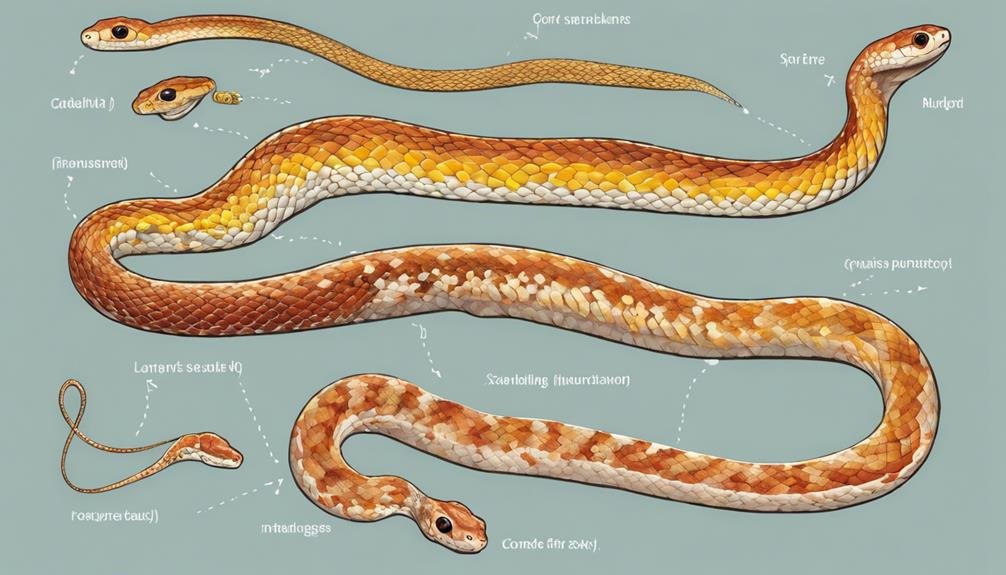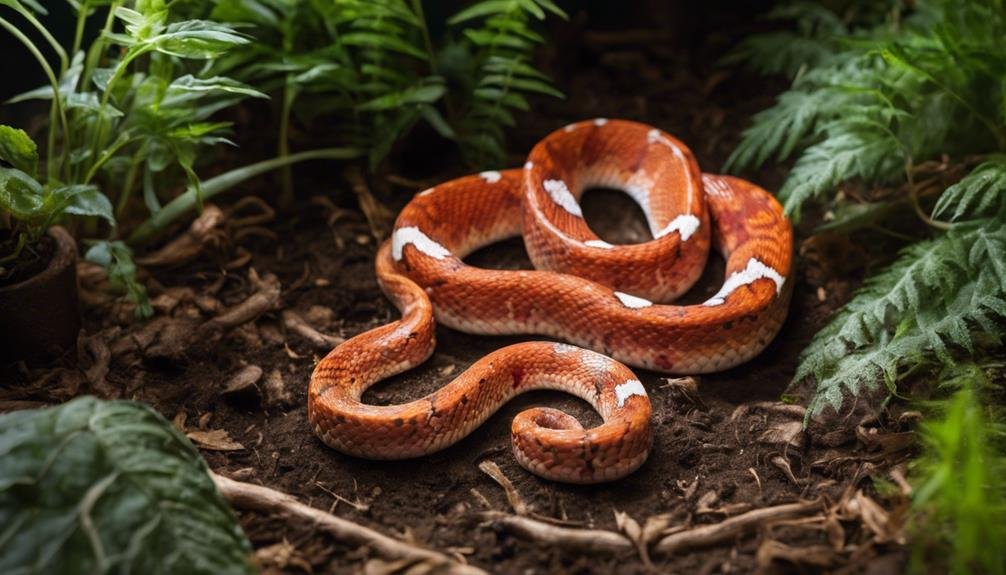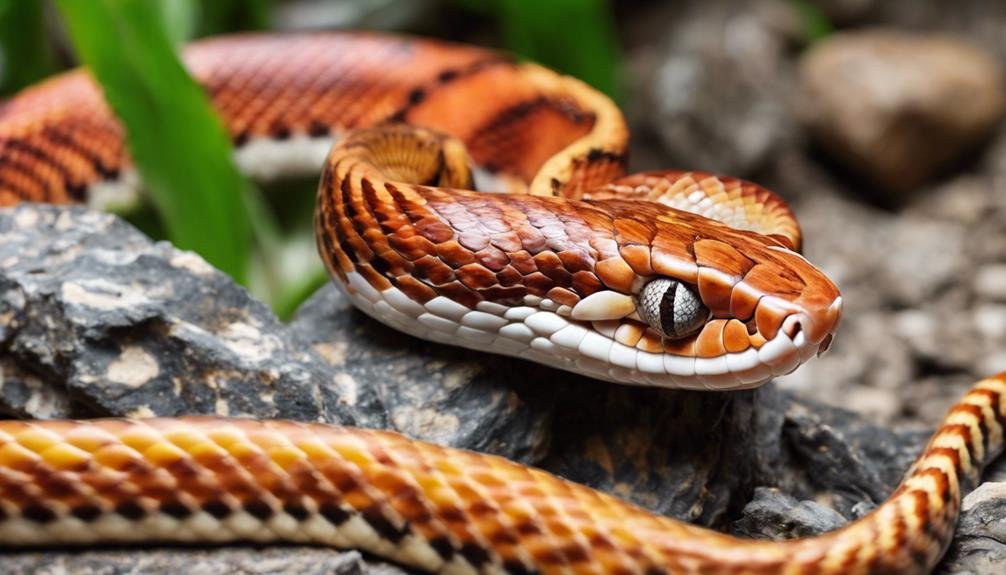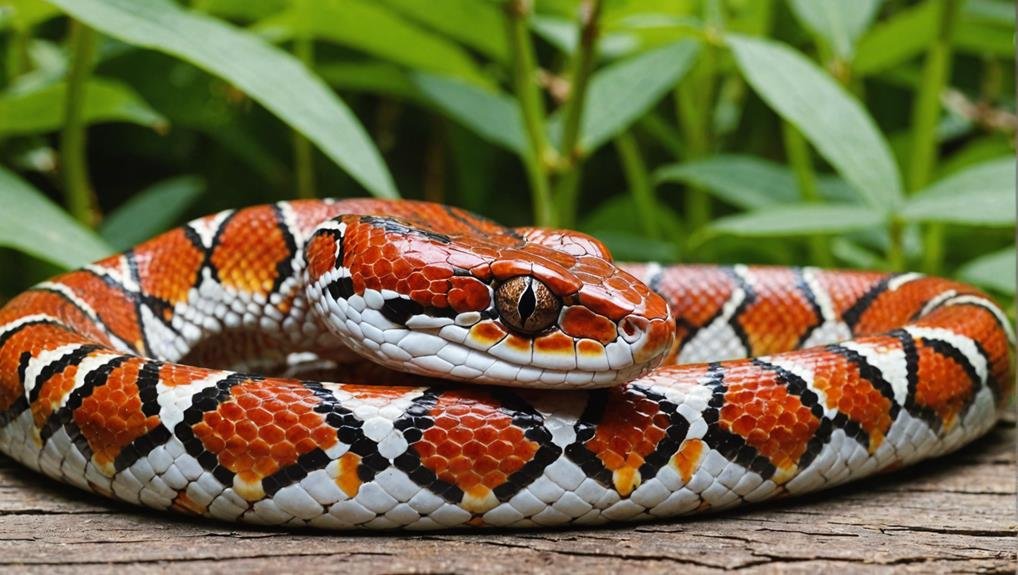Age is important when considering how often a corn snake should shed. Hatchlings typically shed every 4-6 weeks, whereas juveniles shed about once a month, and adults every 2-3 months. However, shedding patterns can vary due to seasonal changes, health, and growth rates. Regular shedding is a good indicator of your snake’s overall well-being, making it essential to monitor these cycles. But what specific signs should you look for to know when a shed is imminent, and how do you create the ideal environment?
Key Takeaways
- Hatchlings shed every 4-6 weeks.
- Juveniles shed approximately once a month.
- Adults shed every 2-3 months.
- Shedding frequency is influenced by age, growth rate, and overall health.
- Proper humidity and hydration are crucial for regular shedding.
Shedding Frequency by Age


When it comes to corn snakes, their shedding frequency changes noticeably as they age. For hatchlings, you’ll observe they shed their skin roughly every 4-6 weeks. This frequent shedding is necessary to accommodate their rapid growth. As they progress into juveniles, the pattern settles a bit, and you can expect them to shed every month. This continued regular shedding supports their ongoing development during this growth phase.
Once your corn snake reaches adulthood, the frequency of shedding decreases significantly. Adult corn snakes typically shed their skin every 2-3 months, about 4-5 times a year. This reduction in shedding frequency aligns with their slower growth rate than their younger years. It’s essential to mention that factors like seasons, breeding cycles, and overall health can influence these shedding patterns.
Understanding these stages is vital for proper care. Regular shedding is a sign of good health; any notable deviations might indicate underlying issues. By monitoring how often your corn snake sheds, you can better assess its health and well-being and ensure it continues to thrive in its environment.
Signs of Upcoming Shed
Noticing the signs of an upcoming shed in your corn snake is vital for its care. You’ll first observe that their scales become lackluster, and their eyes turn cloudy or milky. This is often referred to as being “in blue.” Additionally, you might see some drooping skin under their chin. Your corn snake may also become lethargic and more inclined to hide during this period.
Here’s a quick reference table to help you identify these signs:
| Sign | Description | Action Needed |
|---|---|---|
| Lackluster Scales | Scales lose their usual shine | Monitor humidity, maintain hydration |
| Cloudy/Milky Eyes | Eyes appear foggy | Avoid handling, check for stuck shed |
| Drooping Skin | Loose skin under the chin | Maintain proper humidity |
| Lethargy | Less active than usual | Provide a safe, quiet environment |
| Increased Hiding | Seeks shelter more frequently | Ensure hiding spots are available |
Proper humidity and hydration levels are essential to guarantee a smooth shedding process. Keeping an eye out for these signs can help you provide the best care for your corn snake. Timely identification and addressing issues like stuck sheds can prevent injury and keep your snake healthy.
Factors Influencing Shedding


As your corn snake grows, several factors can greatly influence its shedding process. The shedding frequency varies with age; hatchlings shed every 4-6 weeks, while adults shed approximately every three months. This is primarily because babies grow rapidly, necessitating more frequent sheds.
One of the main factors influencing shedding is the snake’s growth rate. Faster-growing snakes will shed more often. Humidity levels also play a vital role; insufficient humidity can lead to stuck sheds, harming your snake. Ensure the enclosure maintains appropriate humidity to facilitate smooth shedding.
Hydration is another essential factor. A well-hydrated corn snake will have an easier time shedding. Make sure your snake has constant access to fresh water.
The overall health of your snake is crucial, too. A healthy snake will shed regularly without issues, while health problems may disrupt the shedding cycle.
Seasonal changes and breeding cycles can also trigger shedding. You might notice an increase in shedding frequency during certain times of the year. Significant weight changes can also prompt a shed, whether due to growth or other factors. Proper shedding is a sign of good health and farming practices, so monitor these factors closely.
Proper Shedding Environment
To guarantee your corn snake sheds properly, maintain the right humidity and provide a moist hide in a warm part of the enclosure. This setup helps your snake maintain hydration, which is essential for a smooth shedding process. Without these conditions, stuck sheds can occur and lead to health issues.
Humidity and Moist Hides
Creating an ideal shedding environment for your corn snake is essential for its health and comfort. One key factor is maintaining proper humidity levels, ideally between 40% and 60%. Consistent humidity helps your corn snake shed its skin smoothly, avoiding complications like retained shed, which can be harmful.
A moist hide box is an excellent way to provide the necessary humidity. Fill the box with damp sphagnum moss, which retains moisture well and creates a humid microenvironment. Place this moist hide box in a warm enclosure area to maximize its effectiveness.
Your corn snake will likely seek out this spot when it’s ready to shed, as the humidity helps loosen and remove the old skin.
Warmth and Enclosure Setup
Properly maintaining the right warmth and properly setting up the enclosure is necessary for your corn snake’s successful shedding. To help your snake shed their skin regularly, you must provide a warm environment with a temperature range of 75-85°F.
Positioning a heat source on one side of the enclosure creates a warm side, allowing your snake to thermoregulate by moving between warmer and cooler areas.
Proper humidity levels between 40-60% are also essential, as they facilitate shedding. Without adequate humidity, your snake could face issues like stuck sheds, which can lead to skin problems.
Placing a moist hide on the warm side of the enclosure can aid in the shedding process, giving your snake a humid retreat to loosen its old skin.
Consistent monitoring of temperature and humidity levels is key to creating a successful shedding environment. Use reliable thermometers and hygrometers to ensure conditions remain optimal.
Addressing Shedding Issues


When your corn snake struggles with shedding, you’ll notice signs like dull scales, cloudy eyes, or sagging skin.
It’s important to address these issues promptly by ensuring proper humidity and offering gentle assistance.
Recognizing Shedding Problems
Recognizing shedding issues in corn snakes is vital for their health and well-being. You must be attentive to any signs of trouble when corn snakes shed. Look for dull scales, cloudy or bluish eyes, and sagging skin under the chin or throat. These are all indicators that your snake might be experiencing shedding issues.
Also, be mindful if they’re more lethargic or hiding more than usual; these behaviors can indicate shedding problems.
Loss of appetite and timid or defensive behavior are additional symptoms to watch for. Corn snakes shed to accommodate growth or weight changes, so any irregularities in this process could suggest a problem. Hatchlings typically shed every 4-6 weeks, while adults shed every three months. Ensure your snake care routine includes proper humidity and hydration, essential for smooth shedding.
While observing the shedding process, check that the eye caps and the tail tip are shed successfully. Immediately address any stuck shed to prevent injury. Proper shedding indicates good health and farming, so providing the right care and attention is important to ensure your corn snake sheds properly.
Effective Shedding Solutions
Addressing shedding issues in corn snakes requires timely and effective solutions to guarantee their health. When your corn snake struggles to shed about every four to six weeks, immediate action is vital. A stuck shed can indicate dehydration or improper husbandry. To help your pet, provide a moist hide or soak it in lukewarm water for 15-20 minutes. This creates a humid environment that allows the old skin to be loosened without causing injury.
It’s crucial not to forcefully pull off any stuck shed, as doing so can harm your snake. Instead, let the moisture work naturally to release the skin. A warm area in their enclosure also helps facilitate shedding.
| Solution | Benefit |
|---|---|
| Moist hide | It provides a humid environment |
| Soaking | Loosens old skin without injury |
| Warm area | Aids in the natural shedding process |
Ensuring your corn snake’s shed skin is intact indicates good Python Care practices and overall health. Regularly check your snake’s hydration and enclosure conditions to prevent future shedding issues. Proper shedding is a key sign that your corn snake is well-hydrated and in good condition.
Monitoring Shedding Patterns
Keeping an eye on your corn snake’s shedding patterns is essential for maintaining its health and well-being. Juvenile corn snakes typically shed every 2-3 months, while adults shed 1-2 times a year. Hatchlings shed even more frequently, around every 4-6 weeks. This shedding frequency can vary notably based on growth rate, feeding schedule, and overall health.
Monitoring these patterns helps you identify potential health issues early. For instance, if your snake is shedding less often than it should, it could indicate problems with humidity levels, weight changes, or even stress.
Conversely, too frequent shedding might signal overfeeding or rapid growth; both warrant attention.
Make it a habit to Track your snake’s shedding cycle. Jot down the dates and any noticeable changes in behavior or appearance. This record-keeping will help you recognize deviations from the norm and adjust husbandry practices as needed.
Factors like breeding cycles can also influence shedding, so stay observant.
Conclusion
To maintain your corn snake’s health, you’ll need to monitor its shedding cycles closely. Hatchlings shed every 4-6 weeks, juveniles monthly, and adults every 2-3 months. Look for signs of an upcoming shed and ensure their environment is ideal. Address any shedding issues promptly to prevent health problems. Understanding and tracking their shedding patterns guarantee your corn snake stays hydrated and well-cared for. Happy shedding means a content, healthy snake!
FAQs
1. Why Is My Corn Snake Shedding So Much?
Your corn snake’s shedding frequency could be high due to various causes, such as growth, illness, or feeding habits. Monitor its shedding behavior and patterns to spot complications and find appropriate solutions to guarantee its health.
2. How Often Should Adult Corn Snakes Shed?
Adult corn snakes shed typically every 2-3 months. You should monitor their shedding patterns, as this behavior highlights their skin and growth health. Individual growth rates and environmental factors influence variations in shedding frequency.
3. Is It OK to Hold My Corn Snake While It’s Shedding?
No, it’s not OK to hold your corn snake while it’s shedding. Shedding behavior is delicate, and handling tips suggest avoiding interference. AllOK the shedding cycle to complete to prevent stress and ensure a smooth process.
4. How Often Should I Soak My Corn Snake?
It would be best not to soak your corn snake regularly. Focus on its hydration by providing a humid hide. Only wash it if it has a stuck shed. Maintaining a proper bathing schedule guarantees skin health without stressing it.

